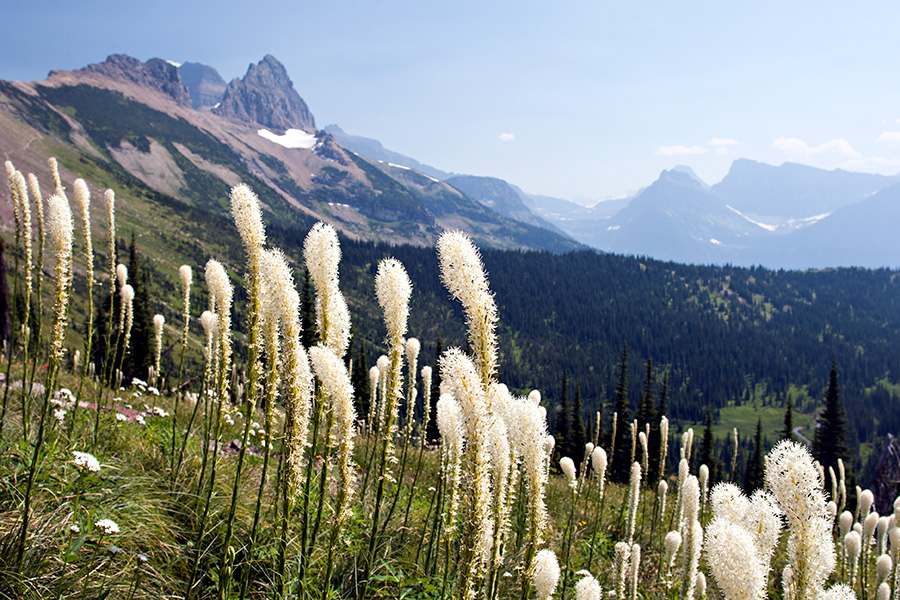A waist-high galaxy of white orbs is stippling the slopes throughout the Flathead Valley, where a mass outbreak of the native wildflower “beargrass” is underway, a sight so mesmerizing it’s been causing “beargrass” jams along Glacier National Park’s scenic roadways.
“Some of the longest-serving rangers who have been here for decades are managing beargrass jams for the first time,” Glacier Park spokesperson Lauren Alley said. “People are really excited about it. It’s incredible.”
Though neither a grass nor a food source for bears, the forest understory is always brighter when it bristles with the flower-tipped stalks, an exciting mosaic for visitors and residents alike in a year that, for a combination of climatological and microbiological reasons, appears to be producing one of the most bountiful beargrass blooms in recent memory.
The spherical shocks of creamy white flowers have been out in full force for weeks, appearing first at elevations above 3,000 feet and radiating upward toward the tree line as the snow recedes.
Xerophullum tenax, as it’s called in Latin, is actually a wildflower — or rather a conical raceme gripping hundreds of small, white flowers in a snowball-like cluster.
The plant was first called beargrass by members of the Lewis and Clark expedition, who mistakenly employed a common name for yucca, known today as soapweed, and which bears a superficial resemblance to beargrass.
“There is a great abundance of a species of bear-grass which grows on every part of these mountains,” wrote Meriwether Lewis on June 15, 1806. “Its growth is luxouriant and continues green all winter but the horses will not eat it.”
But the deer enjoy dining on its aromatic florettes, noshing its tops, while mountain goats browse its green vegetation, which grows on exposed slopes even in winter. Elk and sheep also enjoy snacking on beargrass, and while bears themselves don’t eat it, they do use it for denning material.
Native Americans have historically used beargrass roots to treat injuries and its leaves for weaving water-tight baskets, hence its nickname, “Indian basket grass.” Other common names for this plant include bear lily, pine lily, elk grass, and turkeybeard.
Because beargrass blooms on an irregular schedule, a popular myth holds that the plants blossom once every seven years. In fact, the lily-like basal rosettes await an ideal combination of spring moisture, soil health and summer warmth that may not come together for several years, according to Glacier National Park botanists.
So while some plants produce blooms every year, the mass surges of white blooms tend to occur every five to 10 years, producing a meteor shower of celestial orbs. The plants may have several rosettes, but each rosette only blooms once in its life cycle.
Dawn LaFleur, Glacier National Park’s Integrated Pest Management Supervisory Biologist, said beargrass is highly dependent on spring moisture as well as on healthy soil activity, and in particular the presence of “microfauna.”
“In the 25 years that I have been here, what I’ve seen is that it is really dependent on spring moisture,” LaFleur said, adding that the heavy rainfall that occurred last fall and this spring is a boon to beargrass. “It is also very dependent on the microorganisms in the soil, so if you have happy little microfauna, the beargrass is going to be happy. We had a crazy amount of moisture and a good snowpack, so that really helps the blooms as well.”
LaFleur predicted that the summer would continue to produce prolific amounts of beargrass up to and above Logan Pass in Glacier National Park.
Anecdotally, LaFleur said that a good season for beargrass could translate to a strong year for huckleberries, which also depend on good moisture and healthy microfauna activity.
“I don’t want to make any promises, but so far, so good,” she said. “It looks like it could be a very good year for huckleberries.”
According to Blackfeet Indian legend, a plentiful beargrass season corresponds not only with hulking helpings of hucks, but also the berries’ sweetness.
Besides Montana, beargrass can be found in subalpine meadows and coastal mountains throughout the Pacific Northwest, extending from British Columbia to northern California and eastward to Alberta and northwestern Wyoming.
The plants can grow up to five feet in height with long and wiry, grass-like basal leaves at the base of the stalk.
Visitors are encouraged to experience the abundance of beargrass in Glacier National Park this year, but are reminded that picking flowers or collecting plants is prohibited within the park.
Riley Polumbus, spokesperson at Whitefish Mountain Resort, said the beargrass on Big Mountain is also going gangbusters, and the first two miles of the Danny On hiking trail is wallpapered with white.
Beargrass is best viewed during the early morning hours or just before sundown, giving the striking visual effect of sunlight filtering through the blooms, and the appearance of small, lambent, creamy lights bobbing against the mountain.
